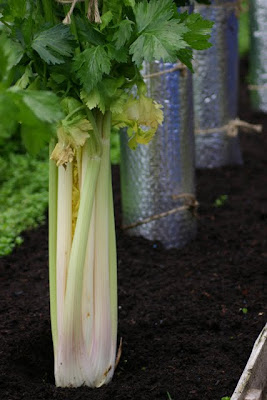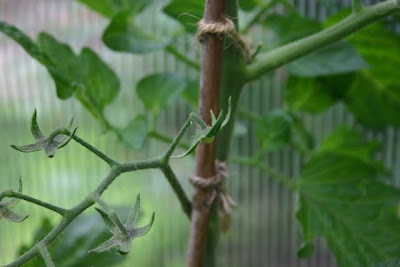 I think this is 'Super marmande'. In any case, many of the larger tomato varieties are now swelling, promising a reasonable crop, though none show signs of ripening just yet.
I think this is 'Super marmande'. In any case, many of the larger tomato varieties are now swelling, promising a reasonable crop, though none show signs of ripening just yet.
I have tasted fewer than half the varieties of tomato I am growing this year - although I think I will be able to try at least one of each before the frosts.
However, seed fever has taken me again, and I have planned next year's list of varieties already. It is subject to change, but only addition - a few of those I have at the moment have not yet proven themselves, but they may be redeemed later in the season. Some seeds remain from the purchases of 6 months ago, so obviously I will start with these. Then, some which I do not have spare, but which have done so well already, I will gather the seeds from. Finally, I have chosen a few varieties that either come highly recommended, or which fill gaps in the size/shape/colour/habit combinations, or whose names I like, or which duplicate 2011's attributes, but might be even better. I'd set my limit at 20 varieties - which sounds like a lot, but in fact, I'd say it's no harder to grow 60 of 20 types than 60 all the same. I knew I'd overshoot a little, so here is the first draft, amounting to 23.
Varieties in bold will be making a return appearance after this year; asterisks denote those whose seeds I will have to collect myself.
Black cherry
Black prince
Brown berry
Carbon
Caspian pink
Cherokee purple
Cream sausage*
Garden peach
Garden pearl
Gardener's delight
German orange strawberry
Great white
Ildi
Japanese black trifele
Jaune flammée*
Jubilee
Plum lemon
Stupice
Sungold
Super marmande
White cherry
White wonder
Zloty ozarowski
A few notes. I will not save seed from this year's crop of 'Gardener's delight', because although they have grown well, the fruits are small, and I am not convinced I have a very good strain (the seeds, if you remember, came free with a magazine a couple of years ago). 'Brown berry' will grow alongside 'Black cherry' - they are very similar, and I want to know which I prefer. 'White cherry' will be compared with this year's 'Snowberry', which has not yet earned a place in the lineup. 'Garden pearl (Gartenperle)' will stand as comparison with 'Gardener's delight'; 'White wonder' with 'Great white' (although the former is smaller); I suppose 'Ildi' is next year's 'Sun belle'. 'Sungold', 'Zloty ozarowski', and 'Jubilee' are there because I realised my favourite tomato colour is orange - and I want to see if anything matches 'Jaune flammée', my absolute favourite of the year so far. 'Garden peach' is a peach tomato - namely, one that has a slight furriness, a fuzz, on its surface, and can look very much like its namesake - a type I nearly tried this year. Finally, all were selected from their peers on the basis of earliest ripening - since my garden clearly isn't hot or sunny enough to get fruit to harvest in the standard number of days (all have been around five weeks behind this year - not always due to incompetence).
So, exciting times. I don't yet know how many plants in total I will grow - 100 seems a nice figure, but it depends on how much I get this year - my goal of 50kg hangs in the balance; if I make it, a hundred will be too many. Of course, if I get an allotment in time, I will grow more.
I'll return to this subject in a few months, when I have finished assessing this year's varieties, and when I've bought the seeds I need.











































